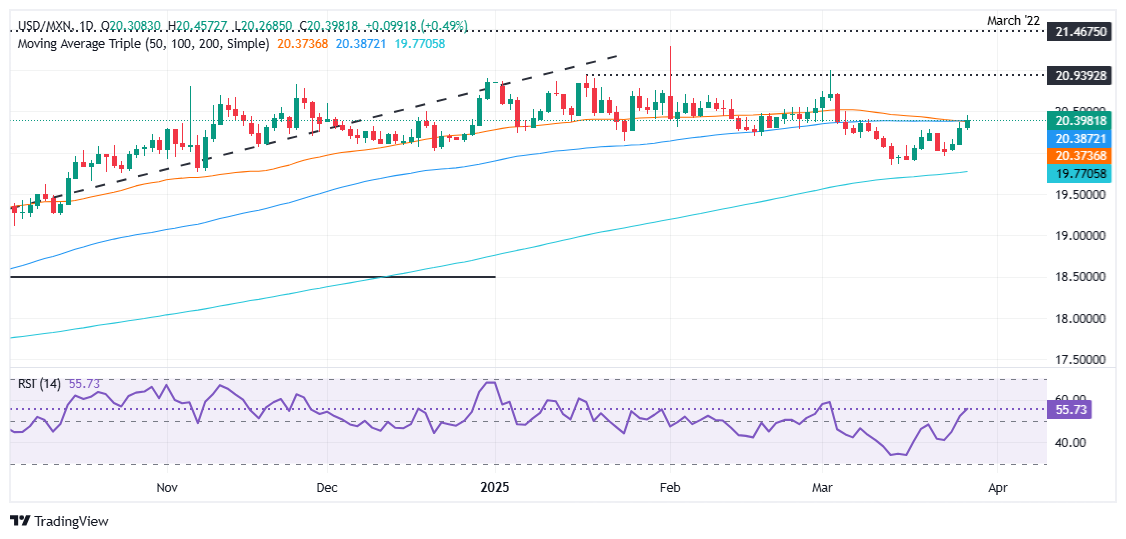Mexican Peso sinks as Banxico cuts, US PCE and tariff fears boost US Dollar
- Mexican Peso weakens for third straight day as dovish Banxico tone, sticky US inflation and trade tensions fuels USD/MXN rally.
- Banxico slashes rates by 50 bps to 9% and signals more easing despite inflation risks skewed to the upside.
- Peso under pressure amid tariff jitters and light Mexico data ahead; focus turns to NFP and ISM next week.
The Mexican Peso (MXN) prolongs its agony in the week, depreciating against the US Dollar (USD) after Banco de Mexico (Banxico) reduced interest rates but also paved the way for additional easing. This, along with an inflation report and trade policies in the United States (US), boosted the Greenback. At the time of writing, USD/MXN exchange rate is 20.43, representing a 0.67% increase.
On Thursday, Banxico cut rates by 50 basis points to 9% on a unanimous decision due to the evolution of the disinflation process, even though it foresees that inflation risks are tilted to the upside. The board anticipates that inflation will continue to ease and “might consider adjusting it in similar magnitudes.”
Aside from economic data, Mexico’s President, Claudia Sheinbaum, commented that the United States-Mexico-Canada Agreement (USMCA) helps North America compete against China, adding that ongoing talks with the US are aimed at protecting jobs in Mexico.
Across the border, the US Bureau of Economic Analysis (BEA) revealed that the Federal Reserve (Fed) preferred inflation gauge, the core Personal Consumption Expenditures (PCE) Price Index, ticked a tenth up, drifting away from the Fed’s 2%.
Other data showed that Consumer Sentiment deteriorated in March, as announced by the University of Michigan (UoM), which also mentioned that inflation expectations have risen sharply, reflecting a consensus amongst all demographic and political affiliations revealed by the survey.
Next week, the Mexican economic schedule will feature Business Confidence, S&P Global Manufacturing PMI and Gross Fixed Investment figures. In the US, traders are focusing on April’s 2 Trump’s tariffs announcement, the ISM Manufacturing PMI for March, JOLTS Job Openings, and Nonfarm Payrolls.
Daily digest market movers: Mexican Peso drops following Banxico’s decision
- Mexico’s Business Confidence in February was 50.4. A reading below that level would indicate that companies are becoming pessimistic about the economy, with the result being its lowest level since May 2021.
- S&P Global Manufacturing PMI remained in contractionary territory for eight straight months at 47.6 in February. A March print beneath this would suggest the economic slowdown is deeper than foreseen.
- The Personal Consumption Expenditure (PCE) Price Index released by the US Bureau of Economic Analysis (BEA) remained unchanged at 2.5% YoY in February.
- The core PCE print expanded 2.8% YoY, up from 2.7% for the same period. Although the prints maintained the status quo, inflation continues to drift away from the Fed’s 2% target.
- The University of Michigan's Consumer Sentiment index deteriorated slightly, falling from 57.9 in the preliminary reading to 57.0. US households turned pessimistic, expecting prices to increase by 5% for one year, while inflation expectations for five years ticked up from 3.9% to 4.1%.
- On Wednesday, Trump signed an executive order adding 25% duties on imported automobiles, effective on April 2. He said that he would announce additional tariffs next week.
- In 2024, the US imported $474 billion worth of automotive products, including passenger cars valued at $220 billion. Mexico, Japan, South Korea, Canada and Germany were the biggest suppliers.
- Traders had priced the Fed to ease policy by 64 basis points (bps) throughout the year, according to data from the Chicago Board of Trade.
USD/MXN technical outlook: Mexican Peso dives as USD/MXN bulls target 20.50

The Mexican currency remains pressured, as depicted by the USD/MXN pair surging sharply, clearing the confluence of the 100 and 50-day Simple Moving Averages (SMAs) near 20.35/36, opening the door to reach 20.45, a new weekly high.
Momentum, as measured by the Relative Strength Index (RSI), is about to cross the latest peak, signaling that bulls are stepping in.
That said, the first resistance for USD/MXN would be 20.50. If surpassed, the next ceiling would be the March 4 peak of 20.99, followed by the year-to-date (YTD) high of 21.28. Conversely, a drop below 20.35/36 paves the way to test the 20.00 mark.
Mexican Peso FAQs
The Mexican Peso (MXN) is the most traded currency among its Latin American peers. Its value is broadly determined by the performance of the Mexican economy, the country’s central bank’s policy, the amount of foreign investment in the country and even the levels of remittances sent by Mexicans who live abroad, particularly in the United States. Geopolitical trends can also move MXN: for example, the process of nearshoring – or the decision by some firms to relocate manufacturing capacity and supply chains closer to their home countries – is also seen as a catalyst for the Mexican currency as the country is considered a key manufacturing hub in the American continent. Another catalyst for MXN is Oil prices as Mexico is a key exporter of the commodity.
The main objective of Mexico’s central bank, also known as Banxico, is to maintain inflation at low and stable levels (at or close to its target of 3%, the midpoint in a tolerance band of between 2% and 4%). To this end, the bank sets an appropriate level of interest rates. When inflation is too high, Banxico will attempt to tame it by raising interest rates, making it more expensive for households and businesses to borrow money, thus cooling demand and the overall economy. Higher interest rates are generally positive for the Mexican Peso (MXN) as they lead to higher yields, making the country a more attractive place for investors. On the contrary, lower interest rates tend to weaken MXN.
Macroeconomic data releases are key to assess the state of the economy and can have an impact on the Mexican Peso (MXN) valuation. A strong Mexican economy, based on high economic growth, low unemployment and high confidence is good for MXN. Not only does it attract more foreign investment but it may encourage the Bank of Mexico (Banxico) to increase interest rates, particularly if this strength comes together with elevated inflation. However, if economic data is weak, MXN is likely to depreciate.
As an emerging-market currency, the Mexican Peso (MXN) tends to strive during risk-on periods, or when investors perceive that broader market risks are low and thus are eager to engage with investments that carry a higher risk. Conversely, MXN tends to weaken at times of market turbulence or economic uncertainty as investors tend to sell higher-risk assets and flee to the more-stable safe havens.

